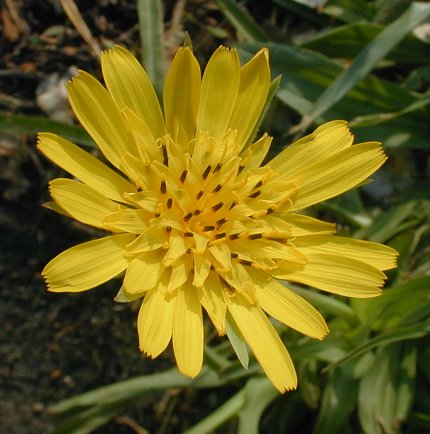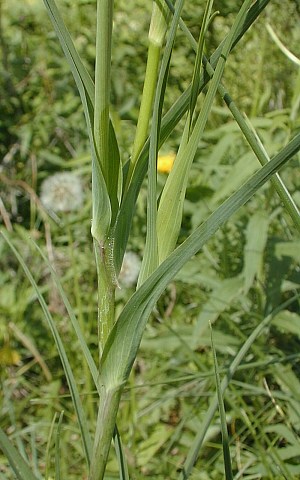Description: This herbaceous biennial plant is a low-growing rosette during the 1st year. During the 2nd year, it sends up one or more flowering stems 1-3' tall. These stems branch sparingly above the withered remains of the rosette. Each stem is round, hairless, and often somewhat enlarged at the base of each leaf. The cauline leaves alternate sparingly and become smaller as they ascend the stems. They are up to 12" long and 1" across, lanceolate-linear in shape, smooth along the margins, and hairless. Their veins run parallel to each other, and at the base each leaf strongly clasps the stem. The basal leaves are similar to the cauline leaves in structure and appearance. Both the stems and leaves contain a white latex. Each stem terminates in a long naked stalk bearing a single flowerhead.

Each flowerhead is
about 2" across when fully open, consisting of numerous yellow ray
florets and about 8 green floral bracts that are lanceolate-linear in
shape. The ray florets spread outward from the center of the
flowerhead; the outer florets are noticeably longer than the inner
florets. Each floret has a truncated tip with 5 small teeth. At its
base, there is a columnar reproductive structure consisting of a yellow
divided style and black anthers that are appressed together around the
middle of the style. The floral bracts extend to about the outer margin
of the flowerhead; sometimes, they are a little shorter or longer than
the width of the flowerhead. The blooming period occurs from late
spring to mid-summer and lasts about 1–1½ months. The flowerheads open
up during the morning and close again by the afternoon. Each floret is
replaced by an oblong achene that has a long thread-like beak, to which
there is attached a tuft of hairs. These hairs are slightly plumose
because they contain small hair-like branches. They are usually white
at the base, but become dull brown toward their tips. Collectively,
these achenes with their tufts of hair form a large spheroid ball that
spans about 3–3½" across. Distribution of the achenes is provided by
the wind. The root system consists of a fleshy taproot. This plant
spreads by reseeding itself.

Cultivation:
Typical
growing conditions are full sun, average to above average levels of
moisture, and a fertile loam or clay loam soil. In sterile soil, where
this plant also occurs, it is usually smaller in size.
Range & Habitat:
The adventive Yellow Goat's Beard is common in central and northern
Illinois, but
occasional or absent in the southern section of the state (see Distribution
Map). It is native to Eurasia. Habitats include mesic black
soil prairies, weedy meadows near woodlands, areas along roads and
railroads, vacant lots, and miscellaneous waste areas. Disturbed areas
are preferred, although this plant can be found occasionally in prairie
remnants along railroads.
Faunal Associations:
Various kinds of bees and flies visit the flowers for nectar or pollen.
Occasionally, spittlebugs can be found where the leaves clasp the stem.
The bitter white latex of the foliage deters the consumption of this
plant by mammalian herbivores to some extent.
Photographic Location:
A woodland meadow in Busey Woods at Urbana, Illinois. The flowerhead
of one photograph is somewhat unusual for this species because the
floral bracts extend beyond its outer margin and are clearly visible.
In the other photograph, the foam of a spittlebug is evident at the
base of one of the leaves.
Comments:
Another common name for Yellow Goat's Beard is Meadow Salsify. It is
closely related to Tragopogon porrifolius (The
Oyster Plant), which is grown as a vegetable because of its edible
roots. However, this latter species has purple flowerheads. Yellow
Goat's Beard has an even closer resemblance to Tragopogon
dubius (Western Goat's Beard), which is also common in the
wild. While Yellow Goat's Beard has bright yellow flowerheads, Western
Goat's Beard usually has pale yellow flowerheads. Yellow Goat's Beard
has about 8 floral bracts that extend to the outer margin of the
flowerhead (or slightly beyond in some cases), while Western Goat's
Beard has about 13 floral bracts that extend considerably beyond the
outer margin of the flowerhead. Also, the foliage of Western Goat's
Beard has a tendency to be more pale green or blue-green in color. The
foliage of Tragopogon spp. (Goat's Beards) resemble
the foliage of Tradescantia spp. (Spiderworts), but
these two groups of plants have very different flowers. Another
difference is the absence of white latex in the foliage of Spiderworts.